Today we’re talking about the most expensive sourcing mistake you could ever make. It is all about the Amazon sales rank: what it is, why it’s important to you and your FBA business, and how it can be deceiving. We talk about some of the key attributes of a sales rank and the ones you should pay the most attention to.
It’s a dangerous affair making buying decisions based only on today’s sales rank, and we will give you the complete breakdown of why this is the most expensive sourcing mistake you could ever make! Bottom line, you must make sure Keepa is involved in every sourcing decision you make. Listen today to hear more about how Keepa helps you avoid this expensive mistake!
Listen on the podcast player below.
Like what you hear? Tell a friend… and be sure to leave us a rating and a review. Here’s how.
Key points from Episode 156:
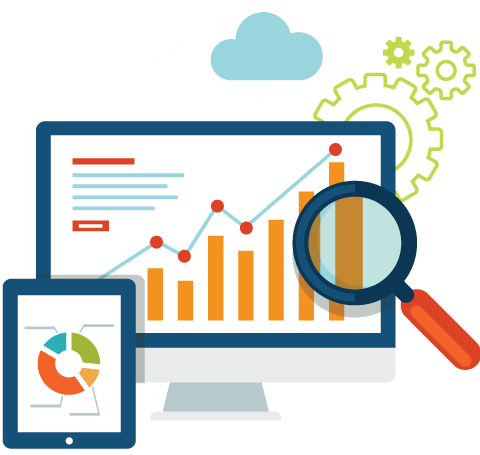 What sales rank is on Amazon and why it’s important for your Amazon FBA business.
What sales rank is on Amazon and why it’s important for your Amazon FBA business.- A costly assumption most beginner Amazon sellers are making while sourcing.
- Key attributes of an Amazon sales rank you need to know.
- Why current sales ranks can be deceiving.
- The danger of making buying decisions based on today’s sales rank.
- The sales rank as an ever-changing entity.
- How one sale could change it all.
- Why Keepa is a must-use tool.
- Examples of how buying decisions based on today’s sales rank can be very expensive.
- The negative impact this mistake also could have on your IPI.
Links and resources mentioned in this episode:
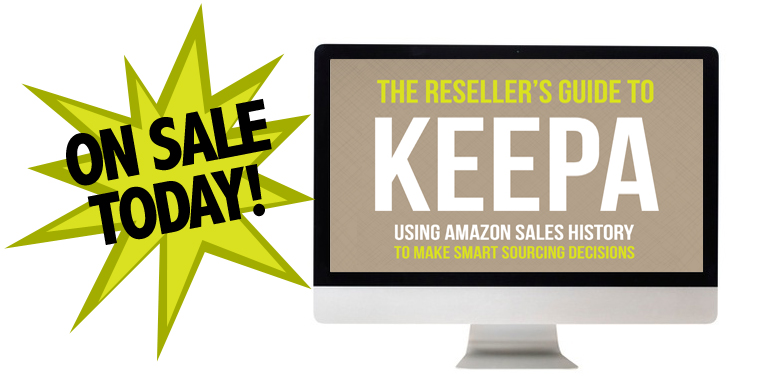 The Reseller’s Guide to Keepa: Using Amazon Sales History to Make Smarter Sourcing Decisions
The Reseller’s Guide to Keepa: Using Amazon Sales History to Make Smarter Sourcing Decisions
- Price going up very soon!
- Keepa – Amazon Sales Rank and Price History Tracker
- How to Read and Understand a Keepa Graph
Right-click here and save as to download this episode to your computer.
![]()
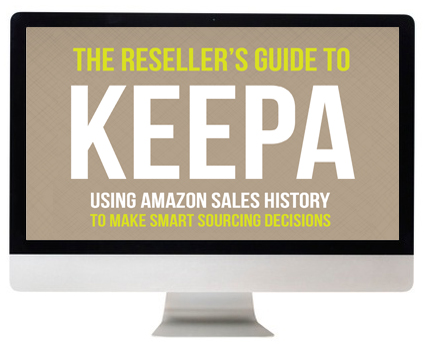 The Reseller’s Guide to Keepa
The Reseller’s Guide to Keepa
(Price Goes Up Soon!)
Have you heard about Keepa? It’s a tool (with both a free and a paid plan) that can dramatically lower the risk of sourcing inventory items that end up tanking in price. I’m sure you know how it feels to buy an item expecting it to sell for a high price only to see the price tank soon after you send it to Amazon. With using Keepa the right way, you can protect yourself from that happening!
Basically, Keepa tracks the vital data on almost every item on Amazon. It can quickly show me the sales rank history, pricing history, buy box price history, used item history, Amazon in stock history, competitors’ stock levels, and so much more. With Keepa, I can easily look at the data from the past and better know what to expect in the future when it comes to price and sales velocity.
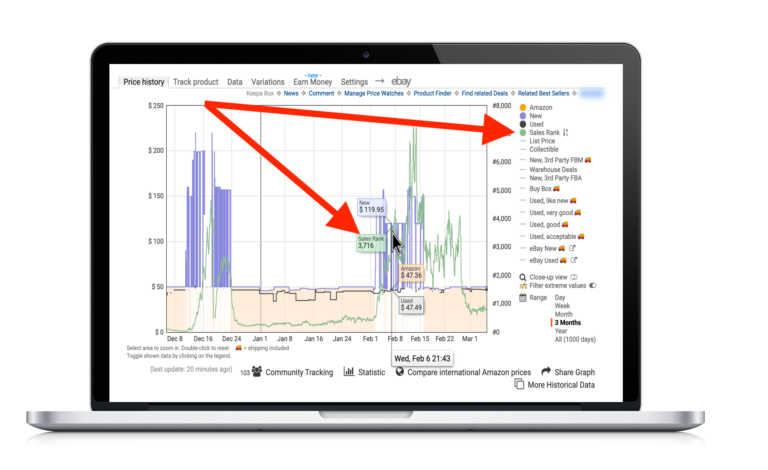 To find out everything there is to know about using Keepa to make smart sourcing decisions, be sure to check out our course, The Reseller’s Guide to Keepa: Using Amazon Sales History to Make Smart Sourcing Decisions.
To find out everything there is to know about using Keepa to make smart sourcing decisions, be sure to check out our course, The Reseller’s Guide to Keepa: Using Amazon Sales History to Make Smart Sourcing Decisions.
With this course, you’ll make more confident sourcing decisions, better pricing decisions, and you’ll grow your Amazon business to the next level by selling your inventory faster and at higher prices!
Back to the main page for The Full-Time FBA Show
More Episodes from the Full-Time FBA Show podcast:
Don’t miss an upcoming episode! Subscribe, download episodes, and review the Full-Time FBA Show:
-
-
- Subscribe on iTunes
- Follow on Spotify
- Follow on Amazon Music (or just ask Alexa to “play The Full-Time FBA Show podcast”)
- Follow on iHeartRadio
- Subscribe on Podbean
- Subscribe on Podbay
- Subscribe on Podchaser
-
![]()
Episode 156 Transcript:

[INTRODUCTION]
[0:00:01.8] ANNOUNCER: Welcome to The Full-Time FBA Show. In each episode, it’s our goal to help you turn part-time hours into a full-time income, selling almost anything on Amazon. Now, your hosts of the show, Stephen and Rebecca Smotherman.
[WELCOME]
[0:00:21.3] REBECCA: Welcome to this episode of The Full-Time FBA Show. We’re so glad you are here with us today. It’s episode number 156 and we’re going to be talking about the most expensive sourcing mistake you could ever make. We do not want you to make this mistake, we have made this mistake in the past and learned from it and that’s why we’re telling you about it, and here with me today to talk about this very expensive sourcing mistake is my cohost, Stephen. How are you doing today Stephen and are you ready to get into this topic?
[0:00:50.0] STEPHEN: I’m excited. I’m doing good and yes, we have made this sourcing mistake so much and it is literally costs us hundreds, and we just want to make sure that you avoid this sourcing mistake so that you actually use your sourcing capital better, and I am just so excited about this, let’s just get right to it, the most expensive sourcing mistake. Here we go.
[DISCUSSION]
[0:01:13.7] REBECCA: So I would say… Stephen said that we have made this mistake so much, I would say in the past we’d made this mistake.
[0:01:19.5] STEPHEN: Right, yes.
[0:01:20.2] REBECCA: This is not something that we typically do on a regular basis now. This is something that we avoid heavily but the reason that we avoid it so heavily now is because it was a super expensive mistake that we made years and years ago, and so we’ve worked really hard to kind of make a process for when we’re sourcing that will help us to avoid this mistake.
There are plenty of mistakes that you can make when it comes to looking for inventory to sell on Amazon for a profit. But this one mistake can really literally cost you hundreds, if not thousands of dollars as you’re sourcing for inventory. This mistake has to do with sales rank on Amazon. So if you have done any selling at all, if you are learning about selling on Amazon, then you know that sales rank is super important when it comes to sourcing profitable inventory.
If you are looking for items to sell on Amazon, one of the first things you’re going to look at is what’s the sales rank and a lot of sellers especially in the beginning just assume, “Oh, the lower the sales rank then the faster the sales velocity of that item,” and that can be true. It is true some of the time that a lower sales rank is going to show a faster sales velocity, but it’s also not true all the time.
There are going to be many times when a low sales rank does not indicate a fast sales velocity. Sales rank is really important but it can also be deceiving if you don’t understand it correctly, and it can cost you potentially hundreds of dollars in profits.
[0:02:44.7] STEPHEN: So a few things about sales rank to know, did you know that an item’s sales rank can improve drastically thanks to just one sale? So, a book ranked 500,000 today, which most people would say is a good bestselling sales rank for books, could have been ranked over 10 million yesterday, and that’s a sales rank that most people would like not purchase at all when it comes to sourcing books to sell.
Or a toy ranked to 90,000 today, which is an awesome sales rank. It’s pretty, it’s low, it could have been ranked 750,000 yesterday, which again, most people would just pass over. So an item that you might want to source today might have been a horrible sales rank yesterday and every day in every Amazon category, so many Amazon sellers are making a sourcing decision based only on today’s sales rank and it’s costing them real money.
[0:03:33.7] REBECCA: So the best way to really think about this concept of Amazon sales rank and understand how it works is that when you look at the sales rank number, you are looking at a snapshot in time. That sales rank number that you are looking at, the current sales rank, it does not ever tell the whole story of the sales velocity of that item. That sales rank is all going to depend on when you are scanning that item and looking at that data, what time, what day are you doing that.
So the most expensive sourcing mistake that you could ever make is making your buying decisions, including how deep you go on a buy, not just whether you buy it but then how many of that item you buy, based only on today’s sales rank.
[0:04:15.0] STEPHEN: So a few more things to understand about sales rank that really support this. First, Amazon updates the sales rank of almost every item on Amazon 24 times a day. So once an hour, the sales rank number of the item that you are looking to source is changing and secondly, just one sale of an item can have a drastic impact on the sales rank of an item where it could improve greatly in just one hour.
So when you are outsourcing, you need to look at more than just today’s sales rank and that’s where Keepa comes in. Keepa is a tool that has a both free and paid service that shows you sales rank history of almost every item on Amazon. So you can look at, you know, today’s sales rank when you are sourcing but you can look at Keepa and see the history of sales rank. You can look at trends with sales rank.
You can see what the overall sales velocity is, you can look at 90-day averages, a 180-day averages, all sorts of different types of information about sales rank that really helps you make a better sourcing decision. If you want to learn more about Keepa, fulltimefba.com/keepa. You can sign up for a free account, play around with it. The paid account is very affordable and very much recommended. I do not do any sourcing without Keepa.
[0:05:26.6] REBECCA: So why are we saying that this type of buying decision where you buy an item without looking at the sales rank history is the most expensive mistake you can make as an Amazon seller. Let me give you an example of why this can be so pricey for you. Let’s say you source an item that’s based only on today’s sales rank when you make that buying decision.
You look at the item, you’d scan it, you are checking out all the information that you normally check out, the price of it looks great, the ROI is going to be good with your buy cost. It’s got a low sales rank for that category, so you think, “I’m going to buy it.” You buy it, you send it in to Amazon, but you didn’t look at the Keepa graph because if you did, you would have seen that this item I am talking about only sells once every six months.
So now that you have sent your item in, you’re going to have about six months of storage fees and those storage fees are going to be about four times what they normally are during Q4, and that is all going to erode your ROI even though you thought you had a great ROI when you are sending it in, that’s return on investment. If you end up having to pay six months of storage fees including some Q4 storage fees, that ROI is gone now.
You are potentially going to be in the hole on those fees that whenever you do finally sell it, you have actually paid more in storage fees than you are going to get back in profit, and all of that is if you’re the only seller of that item because if that item only sells once every six months and there is other people who are also trying to sell it, there’s no guarantee that you are going to be the one to sell without having to lower your price continually.
[0:07:02.4] STEPHEN: Yeah and that’s just money lost on one item. So imagine if you went deep and purchase multiples, maybe even cleared the shelf of all those items that were on the retail shelf, now you’ve got lots of excess inventory too because you know, it is only selling every six months and you’ve got multiples of that. So all that sourcing capital is now tied up in inventory that’s never going to sell.
Your storage fee is multiplied and you eventually, when you figure out that your item is never going to sell, you pay for removal fees and then you try to find the solution of where to sell this item elsewhere. Is it eBay, Facebook Marketplace, garage sale? You’re probably not going to make your money back at all. You are probably going to end up taking a loss, and it all adds up to be a very expensive mistake, all because you didn’t look at the sales rank history of the item that you are sourcing.
[0:07:47.9] REBECCA: All of that is just the expense of the money involved. Another factor that is also very expensive is the impact that this is going to make on your IPI, your inventory performance index. If you have an item that’s sitting there especially if you have multiples of an item that are sitting there at the warehouse for this six months that we’re talking about and all of the storage fees and whatnot go into that, it is also going to be affecting your sell through rate.
It’s eventually, if not very quickly, sometimes Amazon will do it very quickly, sometimes it takes them a while to put that item in your excess inventory and that will then affect your IPI, which will drive down your IPI according to how their algorithm works, and if your IPI goes too low, you could end up with storage limits and so this could impact your business overall, if you get to a point where your IPI causes you to not be able to send in as much inventory as you would like to the Amazon warehouses.
[0:08:44.1] STEPHEN: A third way that it’s expensive has nothing to do with money but has to do with how much time and energy you waste on these items that you send to Amazon that don’t sell, that you waste money on, you’re not making a profit on it and so you know, you are just wasting time and energy on something that’s not going to bring a profit but will instead bring a loss. All that adds to the biggest and most expensive sourcing mistake possible.
[0:09:08.1] REBECCA: Yeah, that mental bandwidth is something that also costs you. So the most expensive sourcing mistake that you can make is making a sourcing decision based only on today’s sales rank, the current sales rank of an item. You can avoid this mistake by taking one extra step when you are sourcing and looking at the Keepa data.
[0:09:27.9] STEPHEN: When it comes to Keepa, it is an amazing tool with so many different features that can help you make a smarter sourcing decision and because of that, I put together a course. The course is called The Resellers Guide to Keepa, using Amazon sales history to make smart sourcing decisions. You can find that course at fulltimefba.com/keepacourse. We’ll also put a link in our shownotes.
We have the very first two lessons free that you can just go watch the video lessons for yourself and see if this course is right for you but I want to let you know that starting right now, we’ve got only a short time before the price goes up. This course is priced way too low and I am realizing with all of the ways we’ve updated the course over the years and all of the benefits that it brings you that this course is just priced way too low.
We are going to be raising the course very soon, so you’d be sure you want to go to fulltimefba.com/keepacourse to help you be able to learn the tool, learn more than just the basics but advanced features for you to make a smarter sourcing decisions. I mean, you can be able to read and understand Keepa graphs in a way where you can look at it for like two or three seconds and know whether or not this is a winner or this is a loser.
We’ve got step-by-step walkthroughs in the course of almost every Keepa feature, how to use Keepa when sourcing variations to make the best sourcing decision, how to buy inventory where the price doesn’t tank all the time. Sales ranks can be really deceptive, we will walk you through and show you the clarity of how to read and understand Keepa’s graphs when it comes to sales rank and even more.
There’s tons of stuff, it is a video-based course that is going to help you find inventory that holds its price and sells consistently and predictably and that is something that every Amazon seller needs. So fulttimefba.com/keepacourse, check it out now before the price goes up.
[CLOSING CONVERSATION]
[0:11:14.3] REBECCA: Thank you so much for joining us for this episode of The Full-Time FBA Show. As a reminder, you can find the transcript for this episode in the shownotes for this episode at fulltimefba.com/156 as well as the link to the Keepa course if you want to go there and click through.
[0:11:30.8] STEPHEN: Next week on the show, we are going to be talking about the second most expensive sourcing mistake you can make. It is a very close second, so we’re going to do this back-to-back on the podcast but be sure to come back next week, so you don’t make this other sourcing mistake as well.
[0:11:44.1] REBECCA: Ooh, cliff hanger.
[0:11:45.7] STEPHEN: Yes, so be sure you’re here next week on The Full-Time FBA Show.
[OUTRO]
[0:11:51.2] ANNOUNCER: That is all for this episode of The Full-Time FBA Show. So head over to fulltimefba.com/podcast, where you will find the shownotes and links from this episode. While you’re there, subscribe to our newsletter where you’ll get several free downloads of our popular and helpful Amazon FBA resources. Now, take action on what you have learned today so you can find success at turning part-time hours into a full-time income with Amazon FBA.
[END]
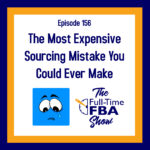

Leave a Reply